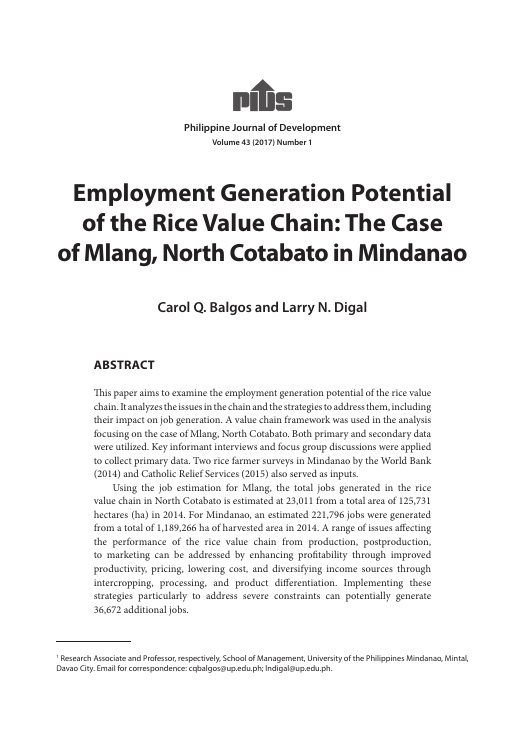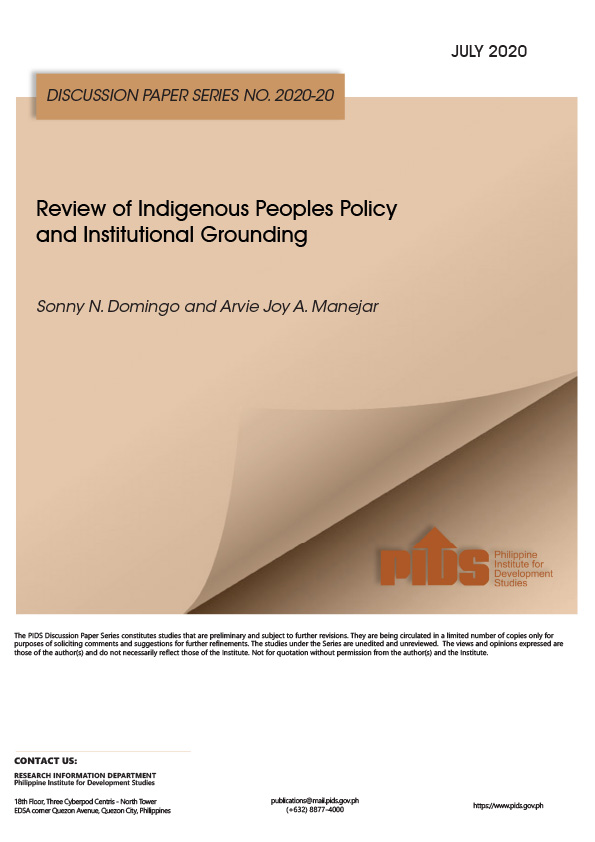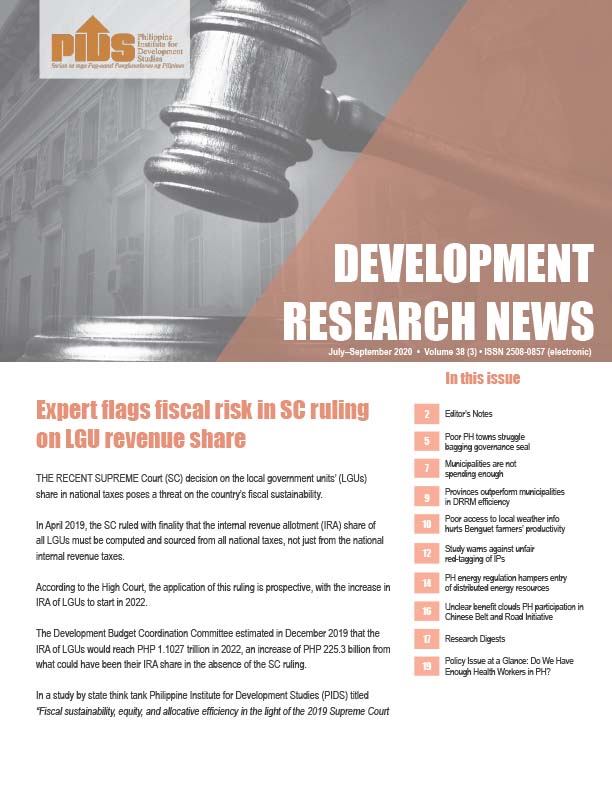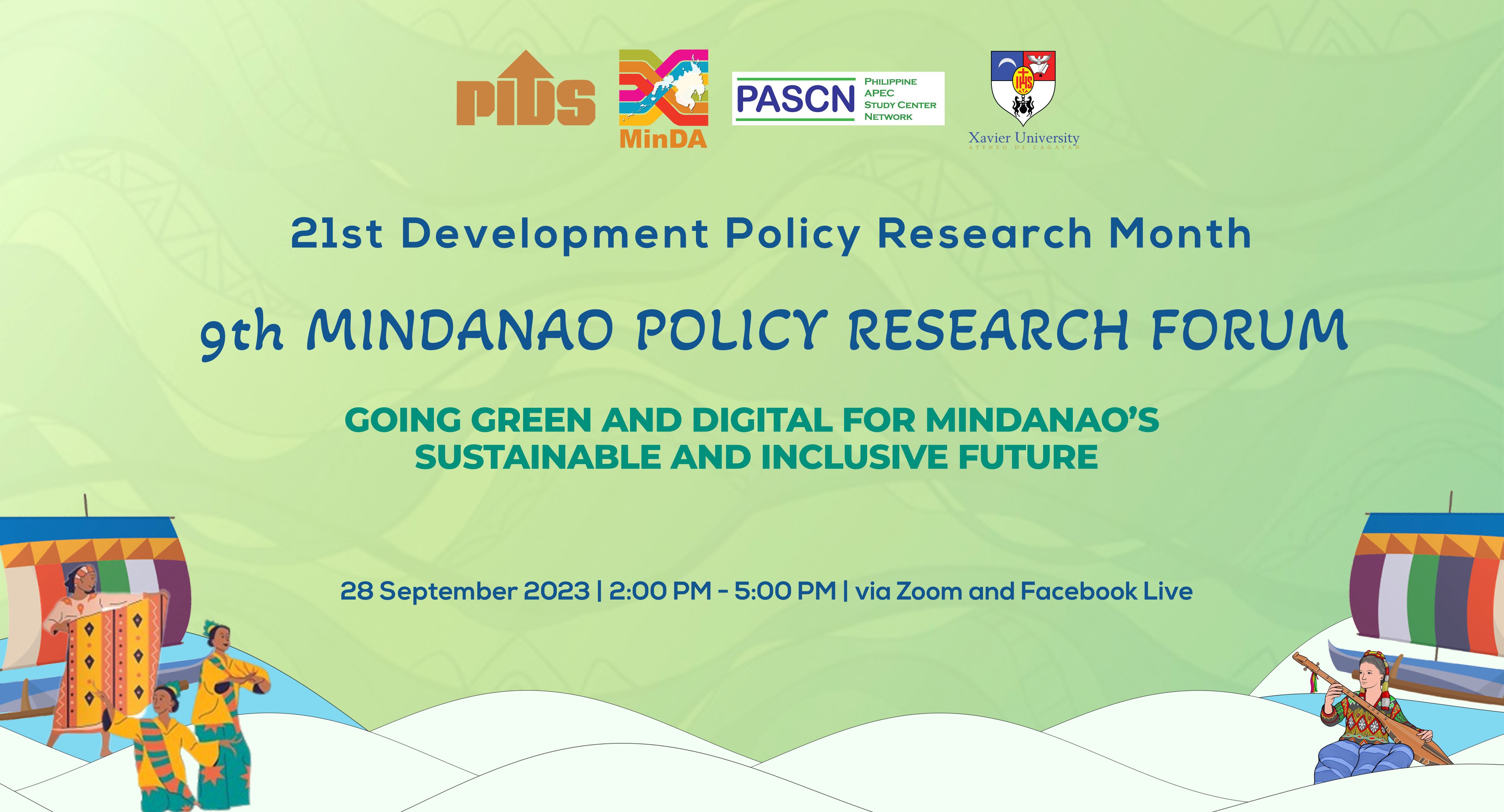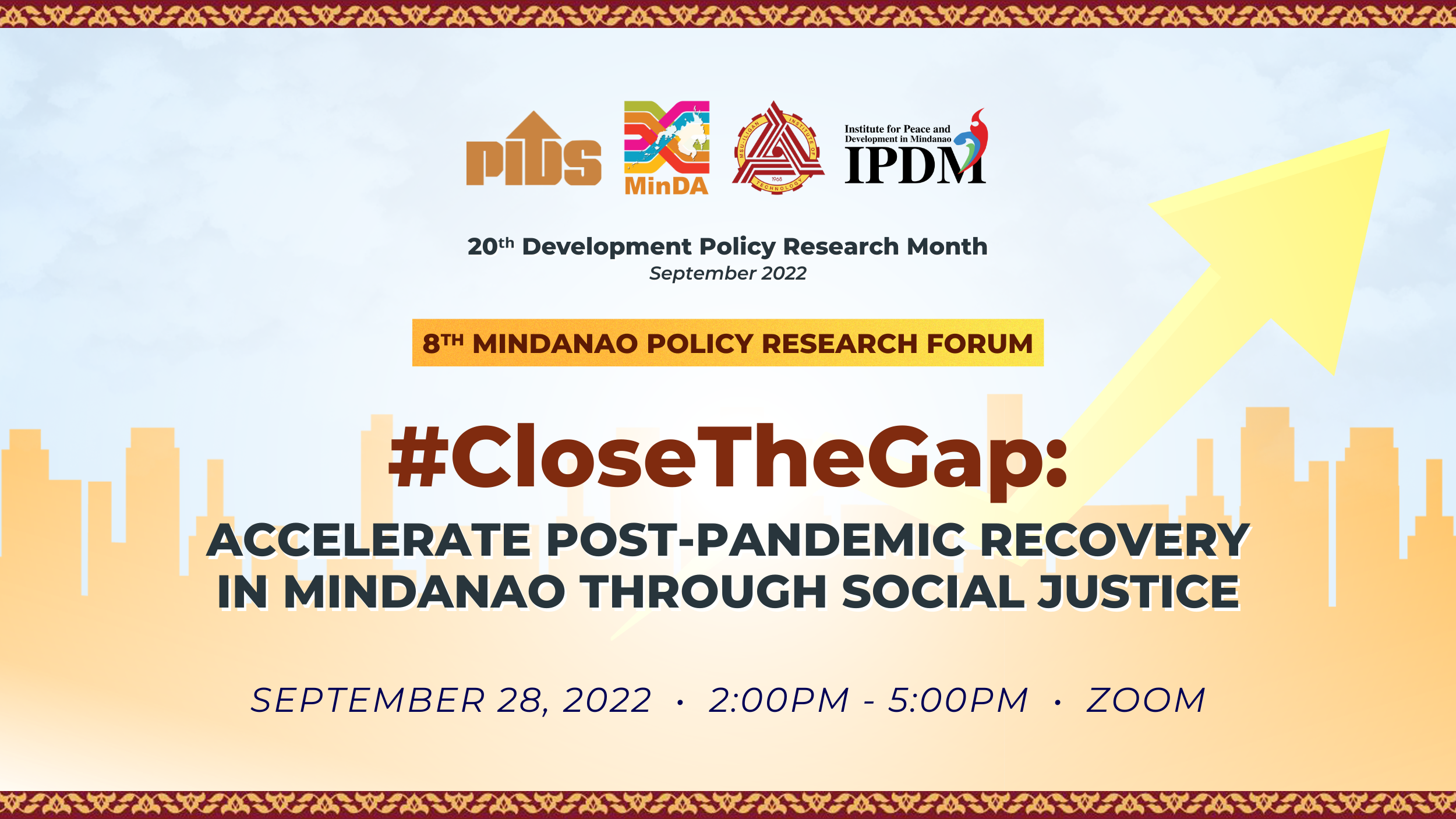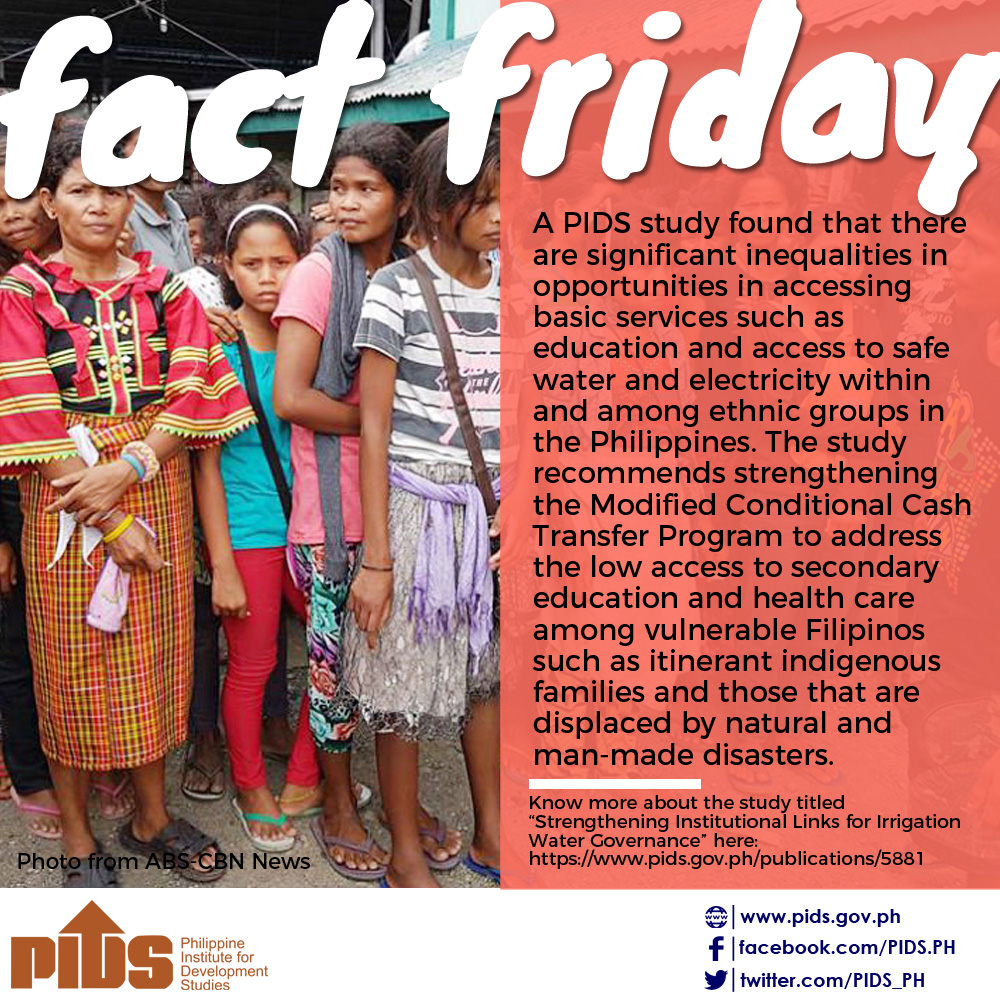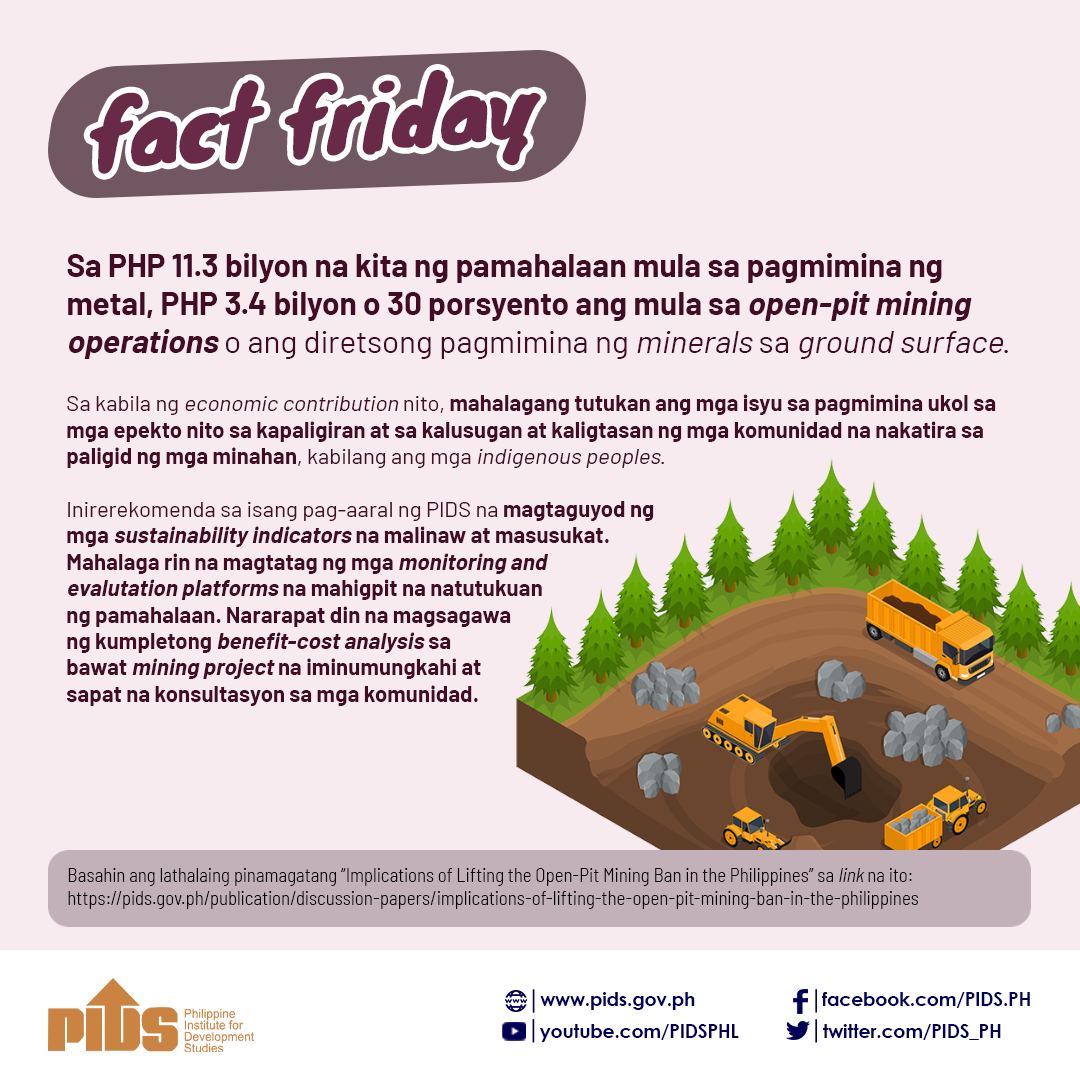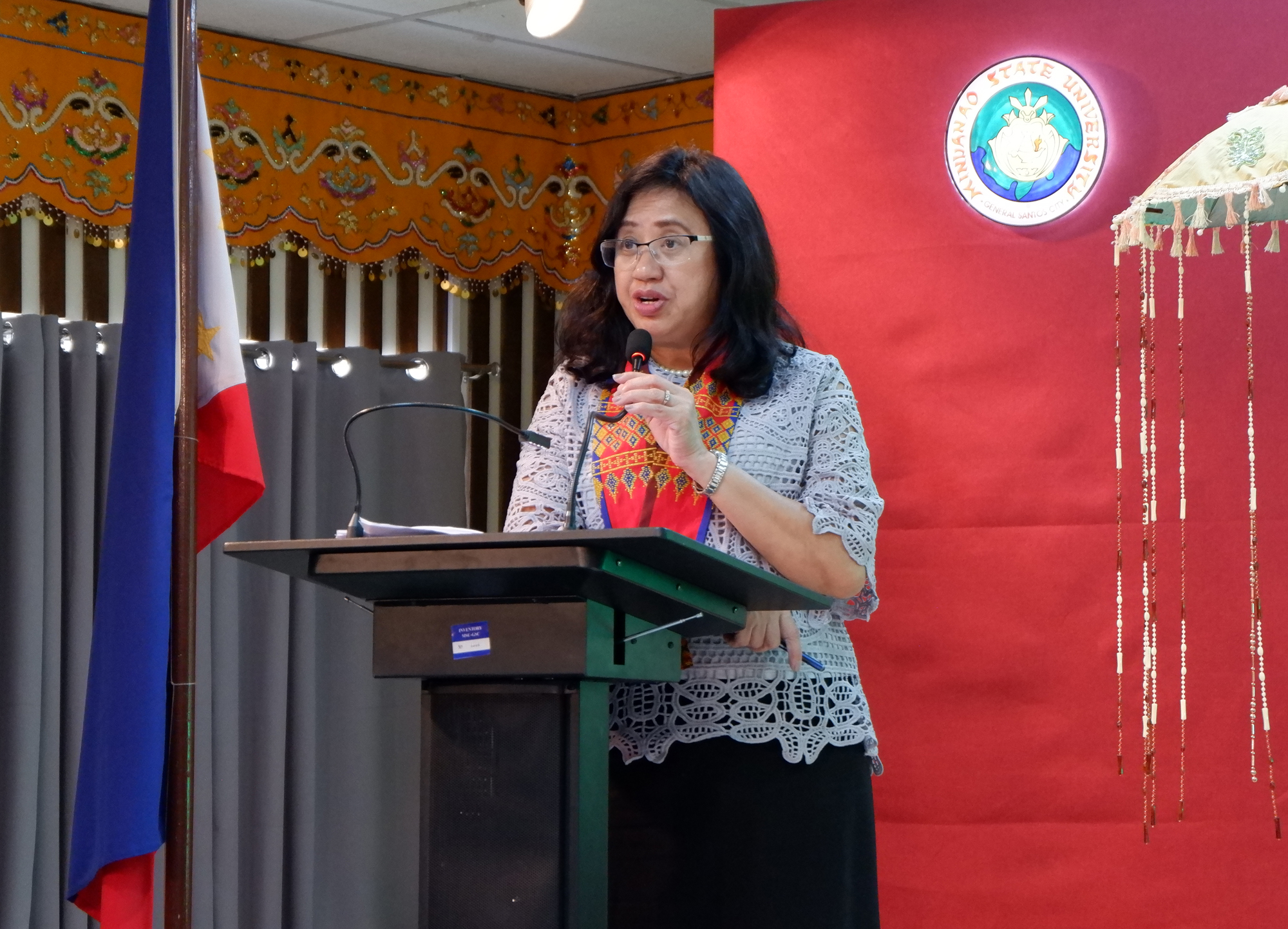
The government is exerting efforts to improve the access of ethnic groups to education, especially those who are in Mindanao, said Philippine Institute for Development Studies (PIDS) President Celia Reyes.
According to Reyes, it is important to reexamine the inequality of education among indigenous peoples (IPs) across the country, especially those in Mindanao, to identify their needs and help government come up with appropriate interventions that will equip them with the skill set required in the era of the New Globalization.
“One of the drivers of the New Globalization is the Fourth Industrial Revolution. For us to be able to take advantage of the advances in modern technologies, we need to have a well-educated workforce—those who can easily adjust to new technologies,” Reyes stressed.
Reyes presented her study on ‘Inequality of Opportunities among Ethnic Groups’ during the Fifth Mindanao Policy Research Forum (MPRF) held recently in General Santos.
“Mindanao ranks low in terms of enrolment rates in basic education, literacy, and school completion (from grades 1 to 6), while it ranks high in terms of school dropouts. Regions 9, 12, and the Bangsamoro Autonomous Region in Muslim Mindanao (BARMM) exhibited the lowest net enrolment rates in elementary and secondary education in 2017. The net enrolment rates in Region 9 is 90.3 percent, 91.9 percent in Region 12, and 72.6 percent in BARMM,” she explained.
The study also showed that the net enrolment in elementary is higher than that of the secondary level. According to Reyes, one possible reason for this is because secondary education is costlier both in terms of direct costs, such as fees and transportation cost, and opportunity costs as older children can already be sent to work to help augment household income.
She also noted that Regions 9, 10, and BARMM have the lowest completion rates in basic education and the highest dropout levels compared to other non-IPs across the country.
The completion rate for elementary education is 78.2 percent in Region 9, 79 percent in Region 10, and 62.1 percent in BARMM. For secondary education, Region 9 has 89.7 percent, 90.1 percent in Region 10, and 54.2 percent in BARMM.
In terms of dropout levels in elementary education, Region 10 has 1.8 percent, Region 9 has 2.4 percent, and BARMM has 11.5 percent. As to dropouts in secondary education, Region 10 has 7 percent, Region 9 has 7.4 percent, and BARMM has 14.1 percent.
Simple and functional literacy rates are also generally lower in Mindanao, particularly in BARMM, compared to other regions in the country. BARMM has 86.1 percent and 72.1 percent in terms of simple and functional literacies, respectively. Simple literacy refers to the ability to read and write simple sentence while functional literacy involves computational skills, among others.
The expansion of the coverage of the Pantawid Pamilyang Pilipino Program (4Ps) to include children in secondary education is one of the government interventions that addresses the inequality in education among IPs.
“We were happy when the Department of Social Welfare and Development took note of our recommendation to expand the coverage of the 4Ps. Dati kasi naka-focus lang siya to children in elementary but we pointed out that the problem really is in accessing education in the secondary level especially now that we have senior high school under the K to 12 program,” Reyes explained.
Another government initiative to improve IP education is the Indigenous Peoples Education (IPEd) Program Support Fund (PSF) of the Department of Education. This program aims to address learning needs of IPs who lack access to basic education services, as well as make school curricula culturally responsive to the specific community context of IP learners, and capacitate teachers, school heads, and other concerned players in implementing culture-based education for IPs.
Local actions to improve access to quality of educ
Meanwhile, Dr. Anshari Ali, Chancellor of the Mindanao State University-General Santos (MSU-GenSan), said their university is intensifying its efforts to help Muslim and other indigenous communities pursue education.
“We usually invite young people, including children of [those who are members] of revolutionary movements to join the university and study in order to become professionals so that they can help their parents in [improving] their economic conditions and in developing their cultural communities,” Ali said.
Ali also shared that MSU is enhancing its fundamental educational system by reintroducing Eastern tradition and teaching universal moral values and good moral characters based on religious injunction in order to produce young generations of wise, responsible, and upright professionals.
The local government of General Santos City is also doing its share to ensure that its constituents are given the opportunity to access quality education.
“As we are transitioning into a new phase of globalization, what local actions are being done by our local government? First and foremost, we prepare our people through adequate education. The city has focused on providing free early childhood education and scholarships for deserving and qualified college students”, said City Councilor and former Mayor Rosalita Nunez, who represented City Mayor Ronnel Rivera during the forum.
Nunez said the city’s Local School Board has developed a strong partnership with DepEd to continuously improve the quality of education to make it responsive to the demands of the New Globalization.
The MPRF is a regular event jointly undertaken by PIDS and the Mindanao Development Authority (MinDA), in partnership with a local university. This year, PIDS and MinDA collaborated with MSU-GenSan. Launched in 2015, the MPRF is part of a series of activities organized every September to celebrate the Development Policy Research Month. ###
According to Reyes, it is important to reexamine the inequality of education among indigenous peoples (IPs) across the country, especially those in Mindanao, to identify their needs and help government come up with appropriate interventions that will equip them with the skill set required in the era of the New Globalization.
“One of the drivers of the New Globalization is the Fourth Industrial Revolution. For us to be able to take advantage of the advances in modern technologies, we need to have a well-educated workforce—those who can easily adjust to new technologies,” Reyes stressed.
Reyes presented her study on ‘Inequality of Opportunities among Ethnic Groups’ during the Fifth Mindanao Policy Research Forum (MPRF) held recently in General Santos.
“Mindanao ranks low in terms of enrolment rates in basic education, literacy, and school completion (from grades 1 to 6), while it ranks high in terms of school dropouts. Regions 9, 12, and the Bangsamoro Autonomous Region in Muslim Mindanao (BARMM) exhibited the lowest net enrolment rates in elementary and secondary education in 2017. The net enrolment rates in Region 9 is 90.3 percent, 91.9 percent in Region 12, and 72.6 percent in BARMM,” she explained.
The study also showed that the net enrolment in elementary is higher than that of the secondary level. According to Reyes, one possible reason for this is because secondary education is costlier both in terms of direct costs, such as fees and transportation cost, and opportunity costs as older children can already be sent to work to help augment household income.
She also noted that Regions 9, 10, and BARMM have the lowest completion rates in basic education and the highest dropout levels compared to other non-IPs across the country.
The completion rate for elementary education is 78.2 percent in Region 9, 79 percent in Region 10, and 62.1 percent in BARMM. For secondary education, Region 9 has 89.7 percent, 90.1 percent in Region 10, and 54.2 percent in BARMM.
In terms of dropout levels in elementary education, Region 10 has 1.8 percent, Region 9 has 2.4 percent, and BARMM has 11.5 percent. As to dropouts in secondary education, Region 10 has 7 percent, Region 9 has 7.4 percent, and BARMM has 14.1 percent.
Simple and functional literacy rates are also generally lower in Mindanao, particularly in BARMM, compared to other regions in the country. BARMM has 86.1 percent and 72.1 percent in terms of simple and functional literacies, respectively. Simple literacy refers to the ability to read and write simple sentence while functional literacy involves computational skills, among others.
The expansion of the coverage of the Pantawid Pamilyang Pilipino Program (4Ps) to include children in secondary education is one of the government interventions that addresses the inequality in education among IPs.
“We were happy when the Department of Social Welfare and Development took note of our recommendation to expand the coverage of the 4Ps. Dati kasi naka-focus lang siya to children in elementary but we pointed out that the problem really is in accessing education in the secondary level especially now that we have senior high school under the K to 12 program,” Reyes explained.
Another government initiative to improve IP education is the Indigenous Peoples Education (IPEd) Program Support Fund (PSF) of the Department of Education. This program aims to address learning needs of IPs who lack access to basic education services, as well as make school curricula culturally responsive to the specific community context of IP learners, and capacitate teachers, school heads, and other concerned players in implementing culture-based education for IPs.
Local actions to improve access to quality of educ
Meanwhile, Dr. Anshari Ali, Chancellor of the Mindanao State University-General Santos (MSU-GenSan), said their university is intensifying its efforts to help Muslim and other indigenous communities pursue education.
“We usually invite young people, including children of [those who are members] of revolutionary movements to join the university and study in order to become professionals so that they can help their parents in [improving] their economic conditions and in developing their cultural communities,” Ali said.
Ali also shared that MSU is enhancing its fundamental educational system by reintroducing Eastern tradition and teaching universal moral values and good moral characters based on religious injunction in order to produce young generations of wise, responsible, and upright professionals.
The local government of General Santos City is also doing its share to ensure that its constituents are given the opportunity to access quality education.
“As we are transitioning into a new phase of globalization, what local actions are being done by our local government? First and foremost, we prepare our people through adequate education. The city has focused on providing free early childhood education and scholarships for deserving and qualified college students”, said City Councilor and former Mayor Rosalita Nunez, who represented City Mayor Ronnel Rivera during the forum.
Nunez said the city’s Local School Board has developed a strong partnership with DepEd to continuously improve the quality of education to make it responsive to the demands of the New Globalization.
The MPRF is a regular event jointly undertaken by PIDS and the Mindanao Development Authority (MinDA), in partnership with a local university. This year, PIDS and MinDA collaborated with MSU-GenSan. Launched in 2015, the MPRF is part of a series of activities organized every September to celebrate the Development Policy Research Month. ###

